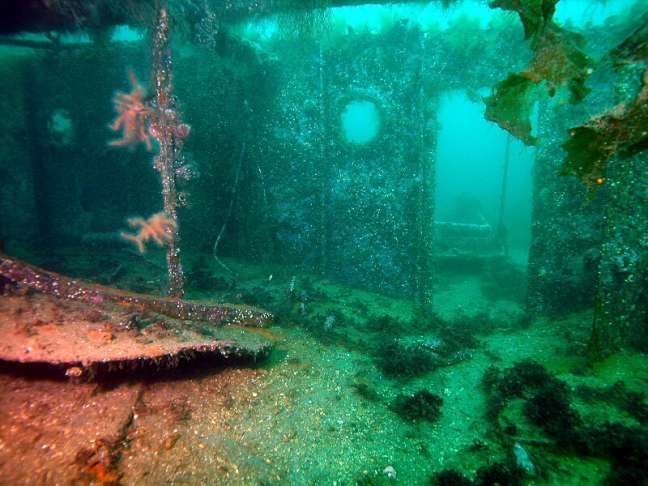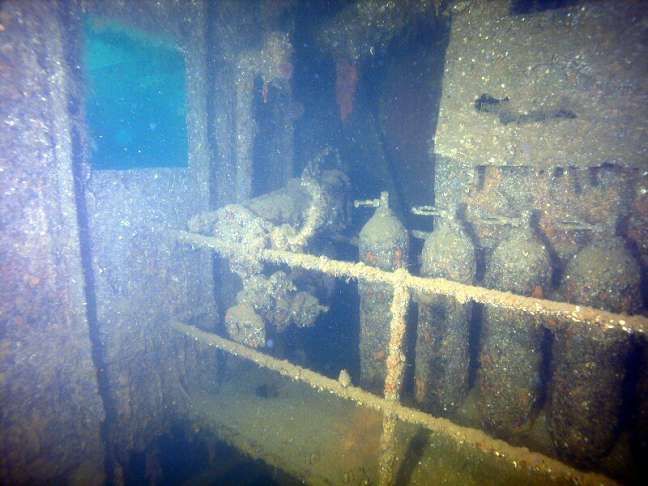MS/STRASSA - NARVIK HISTORIC WRECK
History
M/S Stråssa was one of Grängesbergsbolaget’s first diesel engine ships, built in 1921 at Götaverken. It was named Stråssa after the mining field in Bergslagen and the ship was put on ore shipping, mostly to America. Stråssa’s commander was Captain Åhgren until he had to abandon her in Narvik. Stråssa was on its way to America with a cargo of ore from Narvik on May 8, 1940, when the refrigerator on board broke down, so instead of risking the food on board being spoiled in the heat, it was decided to return to Narvik and repair the refrigerator. On the way in they encountered the German destroyers on their way to occupy Norway and Stråssa was ordered to return to Narvik and anchor in the harbor.
The ship was then held there by the Germans. Here, Stråssa was exposed to shell fire and air strikes during the battles for Narvik. The crew was thus forced to leave the ship. Stråssa, however, survived the battle, but on May 11 a powerful explosion was heard from Stråssa’s bow and a cloud of black smoke was seen above her, after which she sank in about ten minutes. The day before the detonation, it was stated that Germans were seen driving a rowing boat on a car towards the place where Stråssa was located. It was also said that at night you could hear years from the same bay. The naval declaration thus assumed that Stråssa sank as a result of an explosion from an explosive charge placed inside. The crew eventually returned to Sweden and went to sea again with other ships.
Historia
El M/S Stråssa fue uno de los primeros barcos con motor diésel de Grängesbergsbolaget, construido en 1921 en Götaverken. Se llamó Stråssa por el yacimiento minero de Bergslagen y el barco se dedicó al transporte de minerales, principalmente a América. El comandante de Stråssa era el capitán Åhgren hasta que tuvo que abandonarla en Narvik. Stråssa se dirigía a América con un cargamento de mineral desde Narvik el 8 de mayo de 1940, cuando el frigorífico a bordo se estropeó, por lo que en lugar de correr el riesgo de que la comida a bordo se estropeara con el calor, se decidió regresar a Narvik y reparar el refrigerador. En el camino se encontraron con los destructores alemanes que se dirigían a ocupar Noruega y se ordenó a Stråssa que regresara a Narvik y anclara en el puerto.
Luego, los alemanes retuvieron el barco allí. Aquí, Stråssa estuvo expuesta a bombardeos y ataques aéreos durante las batallas por Narvik. Por tanto, la tripulación se vio obligada a abandonar el barco. Stråssa, sin embargo, sobrevivió a la batalla, pero el 11 de mayo se escuchó una poderosa explosión en la proa del Stråssa y se vio una nube de humo negro sobre ella, después de lo cual se hundió en unos diez minutos. El día antes de la detonación, se afirmó que se vio a alemanes conduciendo un bote de remos en un automóvil hacia el lugar donde se encontraba Stråssa. También se decía que por las noches se escuchaban años desde la misma bahía. Por tanto, la declaración naval suponía que el Stråssa se hundió como consecuencia de la explosión de una carga explosiva colocada en su interior. La tripulación finalmente regresó a Suecia y se hizo a la mar nuevamente con otros barcos.
The diving
Stråssa stands at a bottom depth of approx. 26m, but rises up to 14 metres. After the war, the bridge was blown up and pulled off with a cable, so that it would not pose a danger to shipping. The bridge and masts protruded above the surface. The sights on the wreck are many. You can swim through the fine gullies on the sides of the bridge and the engine room, you can also swim into the engine room and see the two large diesel engines sticking up. If you have the right training, you can swim into the workshop behind the machine, where pillar drills and lathes etc. remain. You can also swim from bow to stern all the way inside the wreck. Captain Åhgren’s bathtub can also be found and viewed.
La inmersion
Stråssa se encuentra a una profundidad del fondo de aprox. 26 m, pero se eleva hasta 14 metros. Después de la guerra, el puente fue volado y arrancado con un cable para que no supusiera ningún peligro para el transporte marítimo. El puente y los mástiles sobresalían de la superficie. Las vistas sobre los restos del naufragio son muchas. Se puede nadar a través de los finos barrancos a los lados del puente y de la sala de máquinas, también se puede nadar hasta la sala de máquinas y ver los dos grandes motores diésel sobresaliendo. Si tienes la formación adecuada, puedes nadar hasta el taller detrás de la máquina, donde se encuentran las taladradoras, tornos, etc. También puedes nadar de proa a popa hasta el interior del naufragio. También se puede encontrar y ver la bañera del capitán Åhgren.


ESPAÑOL
Ultimate Narvik Tec Wreck Diving
Octubre 2024
7 noches en habitacion doble en hotel ***
Desayuno, Almuerzo y Con a bordo
10 inmersiones técnicas, profundidad máxima 70m
Pecios propuestos: Z2 Georg Thiele, Z12 Erich Giese , Z19 Herman kunne, S/S Odin
Twinset, lastre, stage S80
Guias en Ingles
1400 € pp
ENGLISH
Ultimate Narvik Tec Wreck Diving
October 2024
7 nights in boat cabin
Fully board (Breakfast, Lunch and Dinner)
10 technical dives max depth 70m
Wrecks proposed: Z2 Georg Thiele, Z12 Erich Giese, Z19 Herman kunne, S/S Odin
Twinset 2x12l, stage S80, wights
English guides
Gasses NO included He 0,07 € per litre. O2 0,02€ per litre
1400 € pp
Expedition Plan
Oct 14-20
Sunday
Arrival in Narvik and boarding MS Galten.
Monday Friday
We will dive on destroyers and cargo ships from the IIWW, the maximum depth will be 70m, 2 dives a day.
Saturday
Loading off MS Galten and journey home from Narvik begins.

